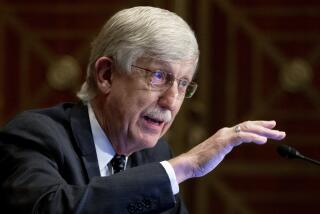FDA creates partnership to boost regulatory science
- Share via
Reporting from Washington — The Food and Drug Administration and the National Institutes of Health on Wednesday announced a plan to help the FDA make swifter decisions about the safety and effectiveness of new products and procedures that flow from advanced research.
The new partnership will promote the development of testing and other tools that FDA regulators need in order to assess drugs and other products coming from fields such as genomics, nanotechnology and stem cell therapy.
Officials from both agencies said laboratory science leading to treatments had vastly outdistanced regulatory science, which develops the methods to evaluate the safety and quality of those treatments.
FDA Commissioner Margaret Hamburg compared the imbalance to the arms of a rower. “We have allowed the arm of regulatory science to become weak and underdeveloped,” Hamburg said at a news briefing. If not corrected, “instead of pulling us into an exalted future, we will row in circles.”
NIH Director Francis Collins said research sponsored by his agency had yielded 128 compounds that showed some degree of promise for medical use, but also presented new challenges for safety regulators.
Some are intended for rare diseases for which there are no established testing protocols.
Others are intended to be used in combination with other therapies, a relatively new approach to treatment of diseases such as cancer and HIV/AIDS.
Because the combinations of drugs can have differing interactions, it’s difficult to assess them for safety, Collins said, adding that “the FDA doesn’t have in place the kind of paradigm that’s needed.”
The NIH-FDA collaboration includes the formation of a six-member council of top scientists from both agencies to make sure that the latest science is incorporated into the regulatory review process.
The NIH and FDA also will make at total of $6.75 million in grants for regulatory science research over a three-year period.
FDA spokeswoman Karen Riley said there were obvious targets for researchers. Among them is trimming the length of time it takes to devise tests for the potency of flu vaccines.
The process currently takes three to four months, but “if we were able to work on it, we think we could cut that in half,” Riley said.






